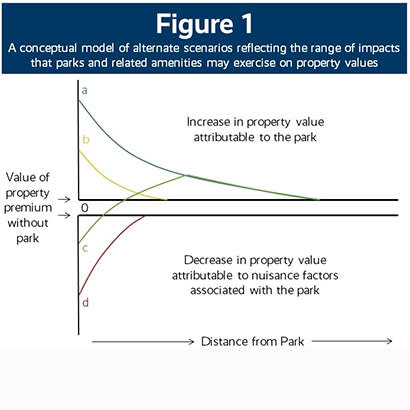
The Board of Commissioners of Central Park in their annual reports from 1856 through 1873 were the first to attempt to answer the question of how much impact parks have on property values. Subsequently, many other studies emerged, but when viewed through today’s lens, their results were naïve and unconvincing because the research tools available to them were relatively primitive.
Around the start of the new millennium, five key methodological developments ushered in a new era of sophisticated studies: (1) research models became more robust, so they could incorporate many more explanatory variables; (2) statistical tools were more sophisticated, so more of the potential factors likely to influence a property’s value could be controlled; (3) multi-listing services’ electronic databases became available, so sales values rather than assessed values could be used; (4) Geographic Information Systems enabled distances between residential dwellings and parks to be measured along street networks, rather than only by straight lines; and (5) electronic mapping meant researchers no longer had to physically visit sites to measure distances and determine access, so sample sizes could be larger.
Impact of Distance from a Park on Sales Price
In a recent article in the Journal of Leisure Research, Sarah Nicholls, a professor in the department of business at Swansea University’s School of Management, and I reviewed 33 studies published in peer-reviewed publications during the new millennium, which measured the impact of distance from a park on the sales price of a residence. The review revealed six insights, comprising:
Direction and Magnitude of Impact. In all but three of the 33 studies a positive premium emerged. The magnitude of the premium reported in each study was assigned to one of three categories: lower than 4 percent, 5 percent to 9 percent and 10 percent or higher.
Approximately the same number of premiums were classified into each category. This led us to conclude that a premium of 8 percent to 10 percent on property values abutting or fronting a passive park in urban environments is a reasonable starting point guideline for developing estimates.
In the three analyses where parks had either no significant impact on sales price or a significant negative impact, the unexpected findings were attributed to noise, congestion and reduced privacy being sufficiently disturbing to adjacent property owners that they outweighed the positive amenity value associated with being close to a park.
Range of the impact. There was reasonable consensus among the studies that parks had a substantial impact up to a distance of 500 to 600 feet. For community-sized parks measuring more than 40 acres, the influence range tended to extend out to 2,000 feet, but after 500 feet the influence was relatively small.
Potential downsides of living adjacent to a park. A majority of studies confirmed that premiums were linear; i.e., they generally were highest for properties closest to a park and influence declined with distance. However, in some cases, homes adjacent to a park did not show the highest premium, because the value of locating next to it was outweighed by negative factors — such as congestion, street parking, litter and vandalism, noise and intrusive ballfield lights.
The impacts of different types of parks are different. Premiums were invariably more positive when properties were close to passive rather than active parks; and proximity to water areas and immediate adjacency to golf courses translated into higher premiums, while proximity to cemeteries, sometimes, resulted in negative premiums.
The size of the park matters. All else being equal, the larger the size of a park, the higher the premium is likely to be. This may be partially explained by larger parks having more buffers to insulate proximate residents from potential negative factors.
Premiums associated with multifamily or small-lot properties were higher than those accruing to single-family or large-lot properties. For many who live in single-family homes, backyards are a preferred substitute for amenities offered at public parks since they often contain items, such as playground equipment, decks, barbeque facilities, basketball hoops, etc. In contrast, those living in multifamily complexes lack such amenities and, consequently, are prepared to pay a higher percentage premium for close access to them.
Conclusions
Results from the 33 reviewed studies varied widely, because the context of each park is unique. Consequently, these generalizations should be viewed as ‘points of departure,’ and it should be recognized that they may not consistently apply in the context of a particular park.
Figure 1 summarizes the generalized results. It recognizes both positive and negative impacts on property values are possible. Its upper half suggests positive premiums associated with proximity and recognizes that they are likely to decline as distance from a park increases. The lower half indicates that any negative impacts are likely to be limited to properties close to a park, and these will decline more rapidly than positive impacts, as distance from the park increases — i.e., the positive curve extends for a greater distance and is likely to be flatter than the negative curve.
A large majority of studies reported results that were best characterized by the ‘a’ or ‘b’ tracks of the figure; i.e., the magnitude of the positive premium decreased with increased distance. However, there were several analyses that reflected the ‘c’ track, indicating that properties immediately adjacent to a park, sometimes, experienced nuisances that nullified the amenity value. Furthermore, only three of the 33 studies reported insignificant or negative impacts characterized by track ‘d.’
John L. Crompton, Ph.D., is a University Distinguished Professor, Regents Professor and Presidential Professor for Teaching Excellence in the Department of Recreation, Park and Tourism Sciences at Texas A&M University and an elected Councilmember for the City of College Station.

